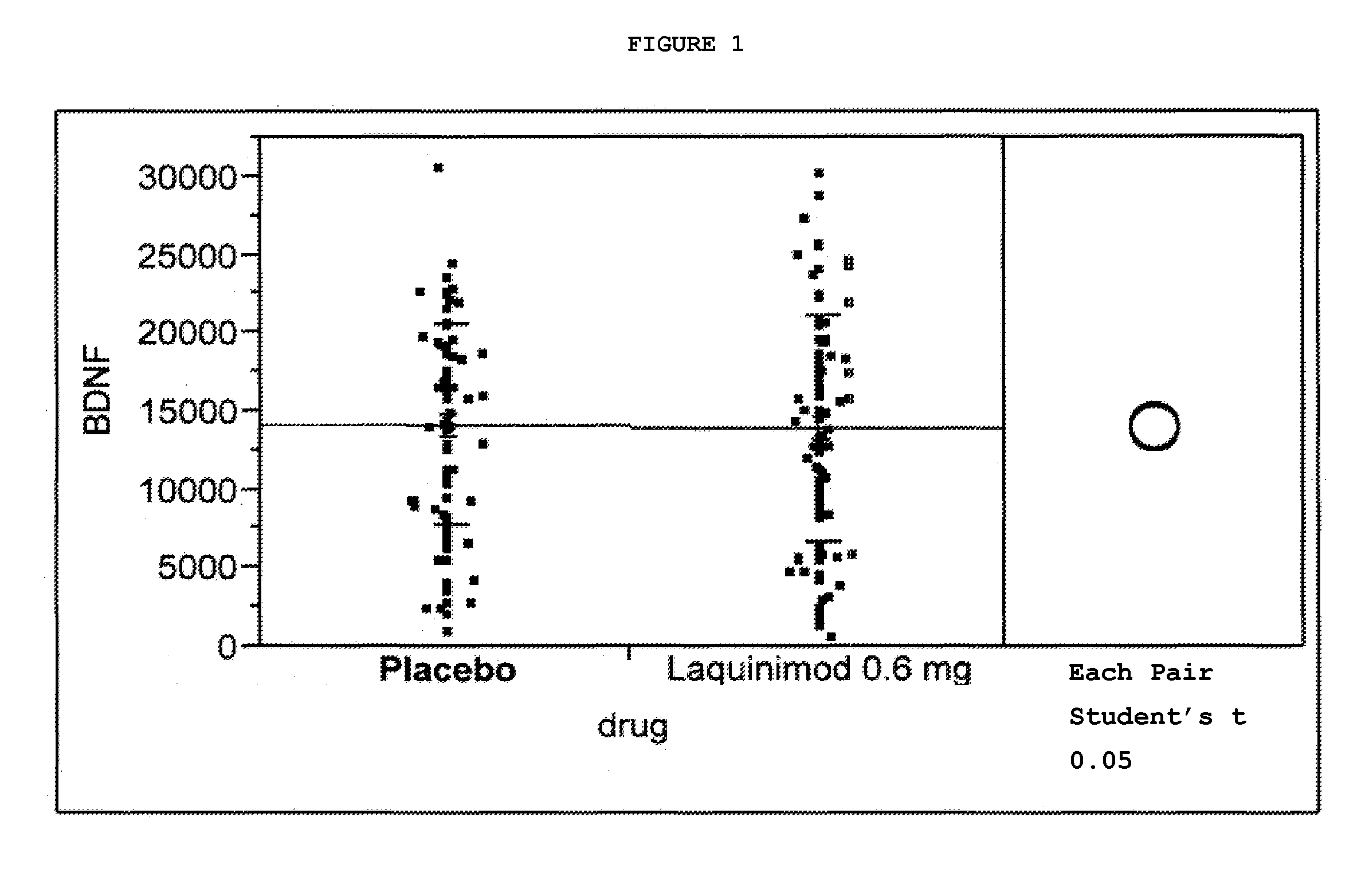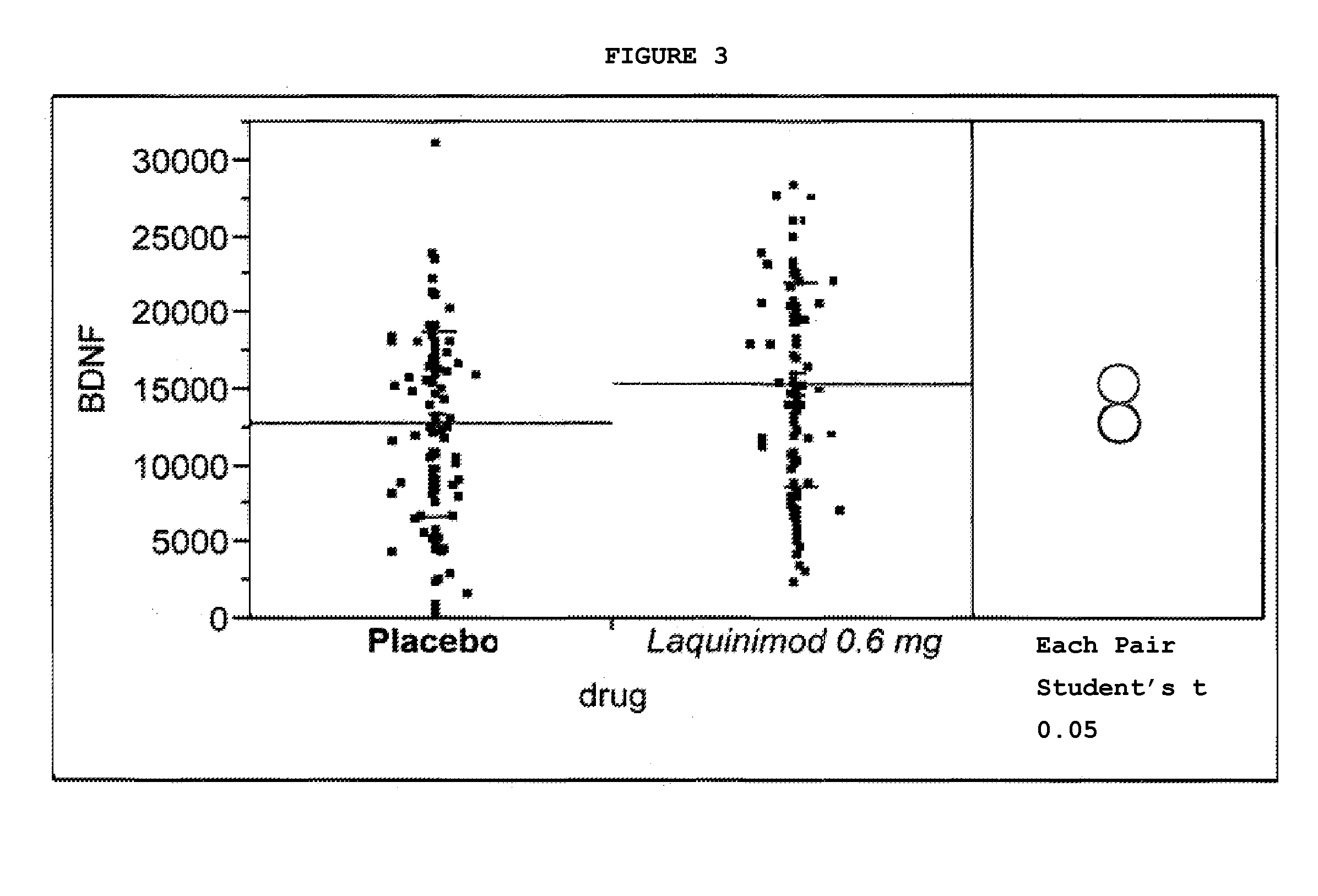Treatment of BDNF-related disorders using laquinimod
a technology of laquinimod and bdnf, which is applied in the direction of biocide, heterocyclic compound active ingredients, drug compositions, etc., can solve the problems of slow progression of disease, impairment of learning and memory in adult stage, etc., and achieve the effect of increasing the level of bdnf serum
- Summary
- Abstract
- Description
- Claims
- Application Information
AI Technical Summary
Benefits of technology
Problems solved by technology
Method used
Image
Examples
example 1
Clinical Trial Showing Effect of Laquinimod on BDNF Levels in Human Subjects Afflicted With Relapsing Remitting Multiple Sclerosis
[0080]A study was initiated in relapsing remitting multiple sclerosis (RRMS) patients using laquinimod, 0.6 mg daily, in the form of the sodium salt, in an oral, once-daily tablet formulation. The study was a multinational, multicenter, randomized, double-blind, parallel-group, placebo controlled study assessing the efficacy, tolerability and safety of two doses of laquinimod in subjects with RRMS. Eligible subjects were randomized into the following three groups:
1. 0.6 mg of laquinimod per os (p.o.) once daily;
2. 0.3 mg of laquinimod per os (p.o.) once daily; and
3. Matching placebo, per os (p.o.) once daily. Subjects must meet the following inclusion criteria to be included in the study:[0081]1. a confirmed MS diagnosis as defined by the McDonald criteria;[0082]2. a RRMS disease course;[0083]3. at least one documented relapse n the 12 months prior to scr...
example 2
Laquinimod Shows Antidepressant Activity in Mice Models—the Forced Swim Test (FST)
[0119]Depression and anxiety disorders are burdensome conditions with lifetime prevalence rates of approximately 7-20%. Animal models are indispensable tools in the search to identify new antidepressant drugs. Various paradigms have been developed and are instrumental in detecting the antidepressant-like potential of novel compounds in preclinical settings (Cryan, 2002; Ganbarana, 2001).
[0120]The Forced Swim Test (FST) is one of the most widely used tools for screening antidepressant activity pre-clinically. The acute test was first described by Porsolt et al (1977).
[0121]The test is based on the observation that rats and mice develop an immobile posture when placed in an inescapable cylinder of water. This behavior is considered to be a behavioral despair as opposed to active form of coping with stressful conditions. An antidepressant will reduce immobility and increase motivated behavior of the roden...
example 2.1
[0126]Balb / c mice were divided to 6 groups (5 / group) and administered daily for 3 days laquinimod (1, 5, 10 and 25 mg / kg per os in the form of laquinimod sodium solution via gavage), fluoxetine (positive control 10 mg / kg per os) or vehicle. On the third day, 90 min following administration, mice were exposed to the forced swim test. Behavior was video recorded and analyzed using Ethovision software (Noldus Holland). The result is shown in FIG. 4.
Conclusion:
[0127]The results show that laquinimod showed a significant antidepressant activity as expressed by the increased mobility and reduced immobility at 1 mg / kg, and a trend to significance at higher doses (Laquinimod at 25 mg / kg). In this experiment, the positive control fluoxetine did not show significant effect, possibly due to non optimal conditions of time and dose.
PUM
| Property | Measurement | Unit |
|---|---|---|
| weight | aaaaa | aaaaa |
| depth | aaaaa | aaaaa |
| diameter | aaaaa | aaaaa |
Abstract
Description
Claims
Application Information
 Login to View More
Login to View More - R&D
- Intellectual Property
- Life Sciences
- Materials
- Tech Scout
- Unparalleled Data Quality
- Higher Quality Content
- 60% Fewer Hallucinations
Browse by: Latest US Patents, China's latest patents, Technical Efficacy Thesaurus, Application Domain, Technology Topic, Popular Technical Reports.
© 2025 PatSnap. All rights reserved.Legal|Privacy policy|Modern Slavery Act Transparency Statement|Sitemap|About US| Contact US: help@patsnap.com



